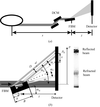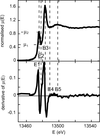issue contents
March 2007 issue

Cover illustration: False-colour images created by chemically selective patterning of a polymethylmethacrylate-polyacrylonitrile (PMMA/PAN) bilayer by focused soft X-rays in the beamline 5.3.2 scanning transmission X-ray microscope at the Advanced Light Source (see Wang, Stöver, Hitchcock and Tyliszczak, pages 181-190). Top: logo of Lawrence Berkeley National Laboratory (left) and logo of the Canadian Light Source (right). PMMA = red, PAN = blue. Bottom left: Smokie the cat. PMMA = brown, PAN grey. Bottom right: grey-scale colour-separated image used as source for the patterned image of Smokie (courtesy of S. G. Urquhart). Scale bars = 1 µm.
facility information
research papers
A bilayer of two polymers (PMMA/PAN) was successfully patterned at ∼150 nm spatial resolution in a chemically selective manner by using tuned synchrotron X-rays focused by a Fresnel zone plate in a scanning transmission X-ray microscope.
A fully automated procedure for detecting and centering protein crystals in the X-ray beam of a macromolecular crystallography beamline has been developed. Because the procedure is based on the number of `good' diffraction spots, the best diffracting part of the crystal is aligned to the X-ray beam.
A two-beam interferometer for hard X-rays has been used to determine the coherence properties of synchrotron radiation up to 50 keV.
The use of Si saw-tooth refractive lenses to focus and collimate high-energy X-rays (50–100 keV) at the APS 1-ID beamline is described.
The total soft X-ray and EUV power which can be emitted by a transition radiation target in the storage rings MIRRORCLE-6X and MIRRORCLE-20SX is estimated. The calculations are performed based on experimental transition radiation data from MIRRORCLE-6X, using optimized one-foil targets, and operating the storage rings at full power.
Br in fluid-inclusion-hosted CO2-bearing solutions exhibits a pre-edge peak not found in CO2-free Br-bearing solutions. The peak is attributed to the effects of CO2 on the hydration and hence the charge density of Br− ions in solution.
laboratory notes
A two-step focusing set-up combining a Fresnel zone plate with an ellipsoidal capillary is presented. An X-ray beam with 15 keV energy was focused down to 250 nm, demonstrating the best spot size that has been achieved up to now for single-bounce capillaries.
current events
Free 



 journal menu
journal menu
































